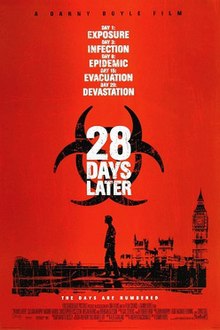 |
| Toga zombie is the worst! |
There zombies have shown up in every part of media from movies, games(board and video), books to even tv, and the mythos for zombies have changed over the years to accommodate trends in the public hysteria or the time.
 |
| The movie known for being the first film to center around zombies |
Early Days: The idea of zombies have been around for a long time, generally being undead slaves to a powerful user of forbidden magic. Originating in Africa, zombies are first apparent in folklore where a person uses witchcraft to control another as a slave without will of its own, generally after being killed and revived. This takes its introductory form into North American culture with the 1932 film, "White Zombie." In it a voodoo priest runs amok with the protagonists love triangle with his ability to resurrect people as slaves.
 |
| The second sequel, and my favorite. |
This type of 'radiation zombie' comes from the leftover hysteria over the successful atomic age horror movies, where the unknown and harmful effects of atomic radiation that transform natural things into horrible unnatural monsters.
This movie sets the standard for the zombie apocalypse genre, where the sheer numbers and ubiquity have started a quick breakdown of society into small pockets of degenerated survivors in a sea of zombie hostility. Its a genre that brings back the epic man versus nature (or in this case, un-nature?) conflict that has been successful in the past.
Shifting Origin: Since George A. Romero's "Dead" series, while the main concept has stayed the same, the cause of the zombie mayhem goes through a shift as people have become more knowledgeable to the facts of radiation poisoning."The Return Of The Living Dead," series during the 1990s, shifted the main culprit to the experimental chemical gas "2-4-5 Trioxin" that changes people into comical corpses that long for human brains. It invoked the fear of pollution and the effects on humans and the environment when the chemical saturates the cemetery ground as a pollutant in rainclouds.
This differs from the "Dead" series not only in the sense of a different back story, but also in the way zombies are spread throughout the world. When radiation turned people into zombies the population at large was already contaminated and one only needed to die to change into a zombie. "Return" started the trend in which a source of contamination spread the zombies in a plague-like fashion and is most common zombie storyline today. It is no longer just a fight to stay alive, but also so as not to contract the zombie disease.
Throughout all the zombie genre, zombies were naturally diseased and people that were bitten by them generally died soon after and turned into zombies and the rest of the group have to deal with the moral consequences of having to kill their friends and family. The difference here is that you don't have to be bitten by them to change into a zombie, only the original contaminate/disease that created them!
So could anything like that actually happen? Can people actually become zombies, rotting necrotic flesh not withstanding? Could an apocalyptic zombie world happen as well? We'll see what science has to say about that in my next post.
-'Till then, True Believers!(as Stan Lee would say)
P.S. - I've posted links to the Monster Island Resort podcast page because the host can explain the intricacies of horror genre in a much more socially aware context than I could ever, so if you're confused about the link, just play the audio file posted on the MIR page.





